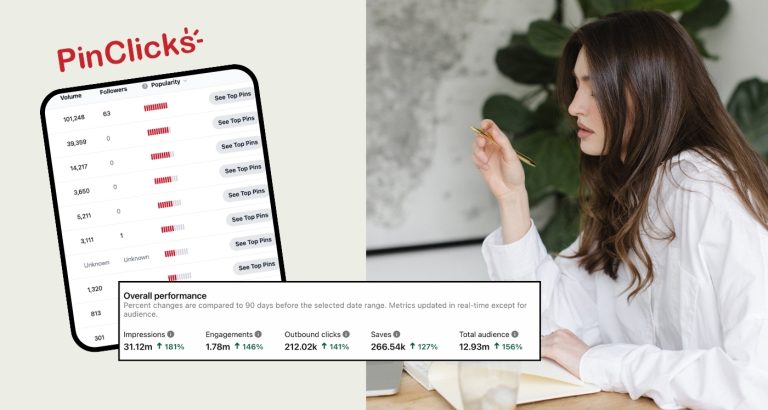11 Newbie-Friendly SEO Tips For Beginners

Want to learn how to get more organic search traffic from Google, and other search engines? Follow these tips to improve the SEO on your website! The ideas in this list are perfect for beginners and can give your site a serious SEO boost. As a blogger, it’s important to make search engine optimization a top priority.
What Is SEO?
SEO stands for search engine optimization. Improving your SEO will help your website gain organic search traffic by helping your pages to to rank higher in Google Search Results (and other search engines).
As an affiliate partner of various brands and sponsored content, HerPaperRoute may earn commission on qualifying purchases. Disclaimer
This list of SEO ideas and tips will help you optimize your website and improve your search engine optimization! It’s important to focus on growing organic search traffic because it’s the most steady and constant traffic source.
SEO Tip 1: Setup Google Search Console
Google Search Console is a free service offered by Google. It’s a tool that will help you monitor, maintain, and troubleshoot your site’s presence in Google search results. Search console can be helpful for seeing what’s working, and what’s not.
The primary use for Google Search Console for is verifying that your blog posts are indexed probably, and available to be seen on Google’s search results.
Google search console also offers insights on which keywords your site ranks. It provides statistics on how many clicks you’re getting, as well as CTR (click through rate). CTR is a good statistic for measuring how ‘clickable’ your titles are. See tip #9 for more information on creating a great title!
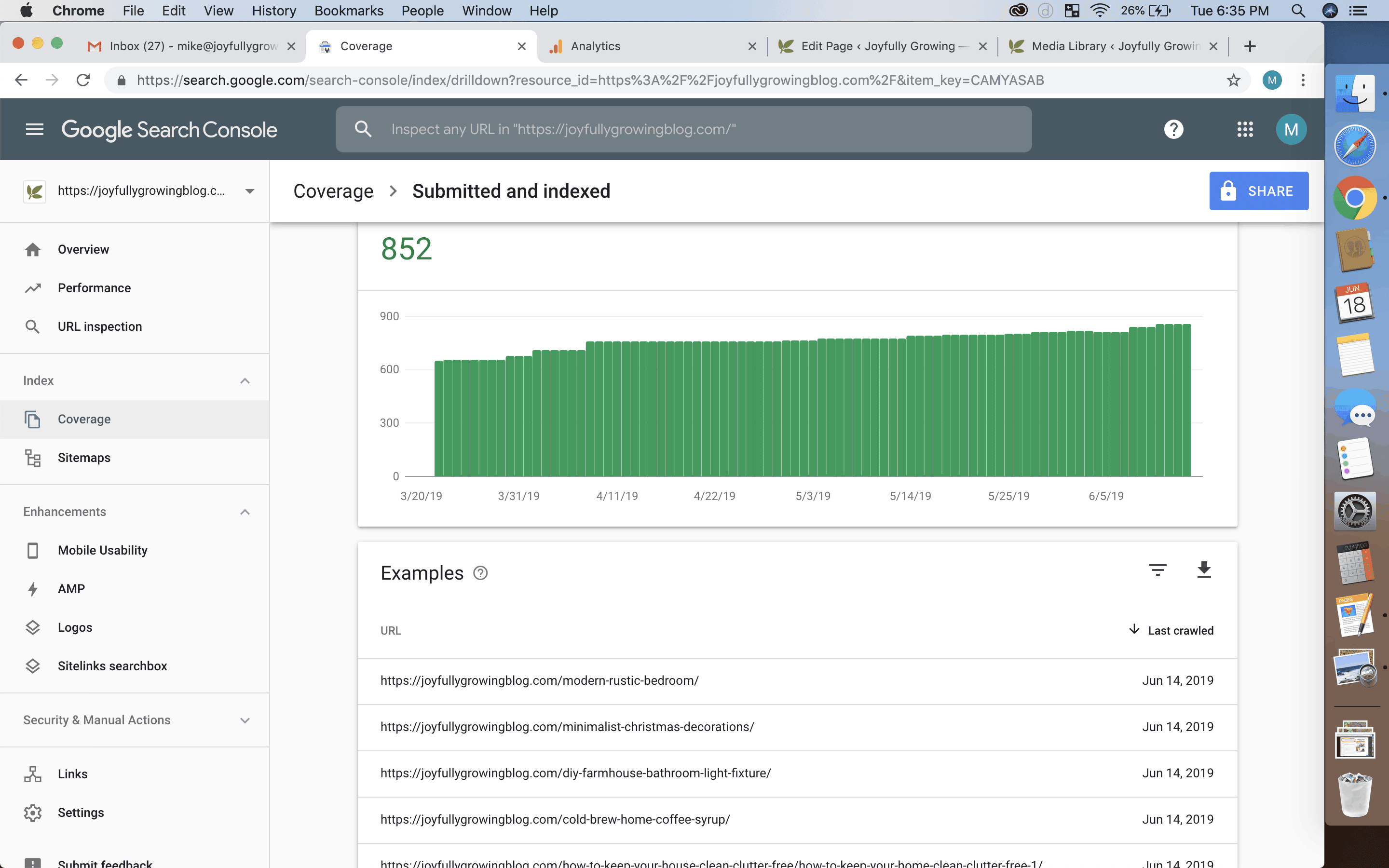
SEO Tip 2: Do Your Keyword Research
Do your keyword research BEFORE you write a blog post. Even if you have an excellent idea, amazing copy, and stunning images – it’s not guaranteed that the post will do well. It’s important to do keyword research to give your post the best possible chance to succeed. Remember, we want to work smarter not harder!
While doing keyword research, your mission is to find a specific keyword (or a few keywords) that you want to try to rank for. I like to try to find a keyword that has adequate search volume (but not too much) and low or medium competition.
Try out Google Keyword Planner
My favorite free keyword research tool is Keyword Planner, which is inside of Google Ads. To get access to Keyword Planner, you will have to set up a Google Ads account, and launch a campaign.
If you don’t need a paid advertising campaign right now, you can just make something up quickly and set the max budget to $1/day. Once the new Google Ads campaign is active, you can put the campaign on pause. If you pause it right away, you won’t be charged!
In the example below, the keyword “SEO tips” gets an average monthly search volume of 1,300, and has low competition. These are both great!
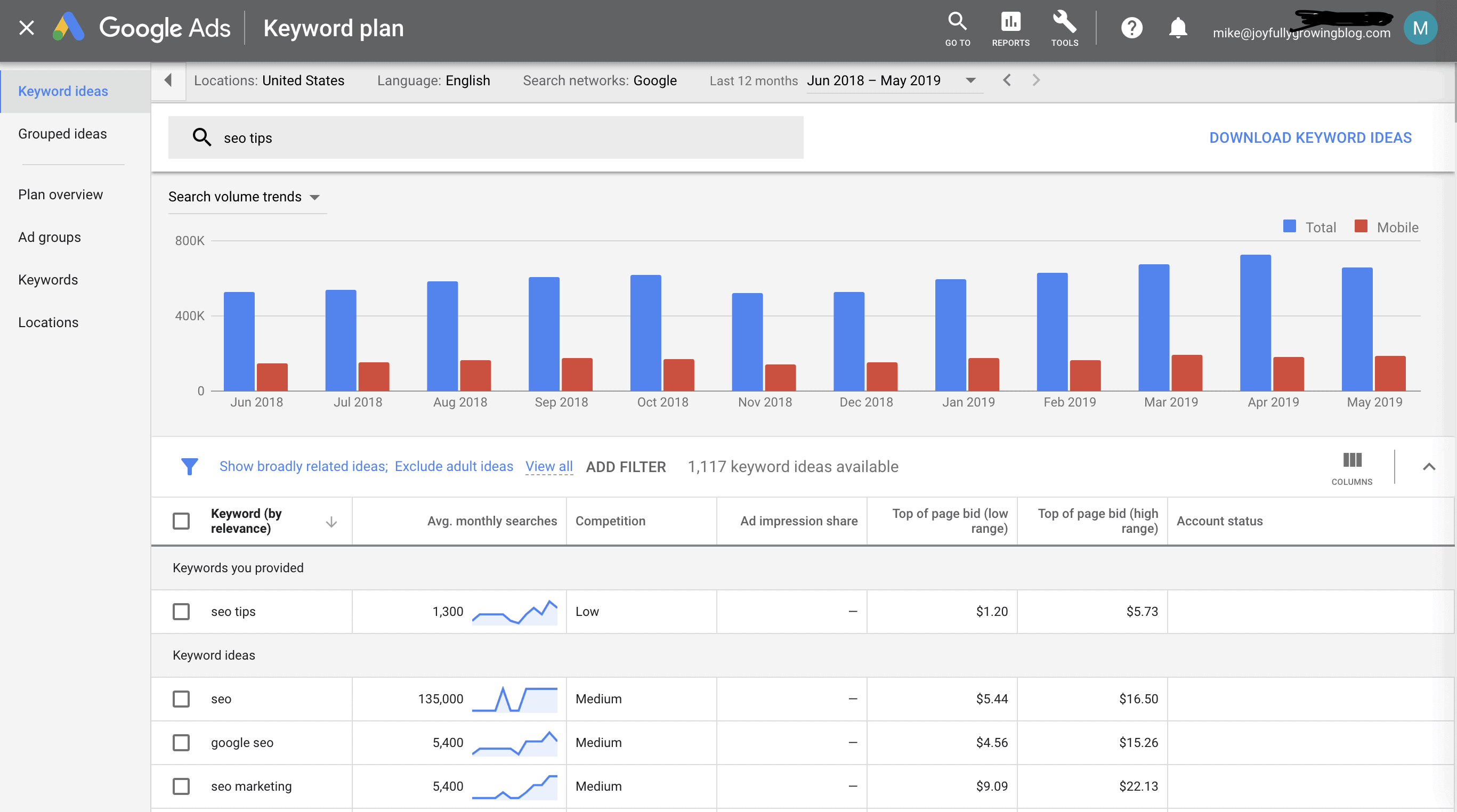
The level of competition for every niche is different, so you’ll have to try things out for yourself. If you’re just starting out, try targeting keywords with less competition. This will give you a good shot at ranking highly.
Do A Google Search To Check Out Your Competition
Before you decide on a keyword, search Google for the keyword you’re considering. Searching inside of an incognito tab will give you more accurate results (because the results are not curated specifically to you). This lets you see which websites you’ll be competing against for a spot near the top of the Google search results.
If the first page of search results is full of sites like: Amazon, CNN, Apple, Cnet, Microsoft, Walmart or any other massive websites… then let me be the bearer of bad news; you aren’t going to beat these mega-websites, so keep searching for a keyword that is more realistic. If you can’t make it to the first page of the search results, you will get very little traffic.
Search engine users typically only look at ‘page 1’ of the search results. If they didn’t find what they were looking for on the first page, it’s likely that they will try new search term instead of clicking through to page 2 and page 3.
SEO Tip 3: Install The Tasty Pins Plugin
Pinterest is another excellent source of traffic for blogs, and having good pin descriptions is essential to succeeding on the platform. This is because Pinterest needs to understand exactly what your images are, so they can show them for relevant search queries. You want to give Pinterest as many clues as possible as to what your pin is about; don’t make them guess!
A good description is well thought out, and packed full of keywords that real users are searching for. While keywords are important, the copy still needs to make sense and flow in natural sentences.
It’s possible to manually designate Pinterest descriptions with HTML code for each image, but that’s extremely time-consuming. The easier option is to use a plugin that makes it easy to set Pinterest descriptions, no HTML required.
Tasty Pins Plugin will save you a ton of time, which makes it worth every penny. The plugin adds a Pinterest textbox to ‘image details’ in the WordPress user interface for images. See the image below.
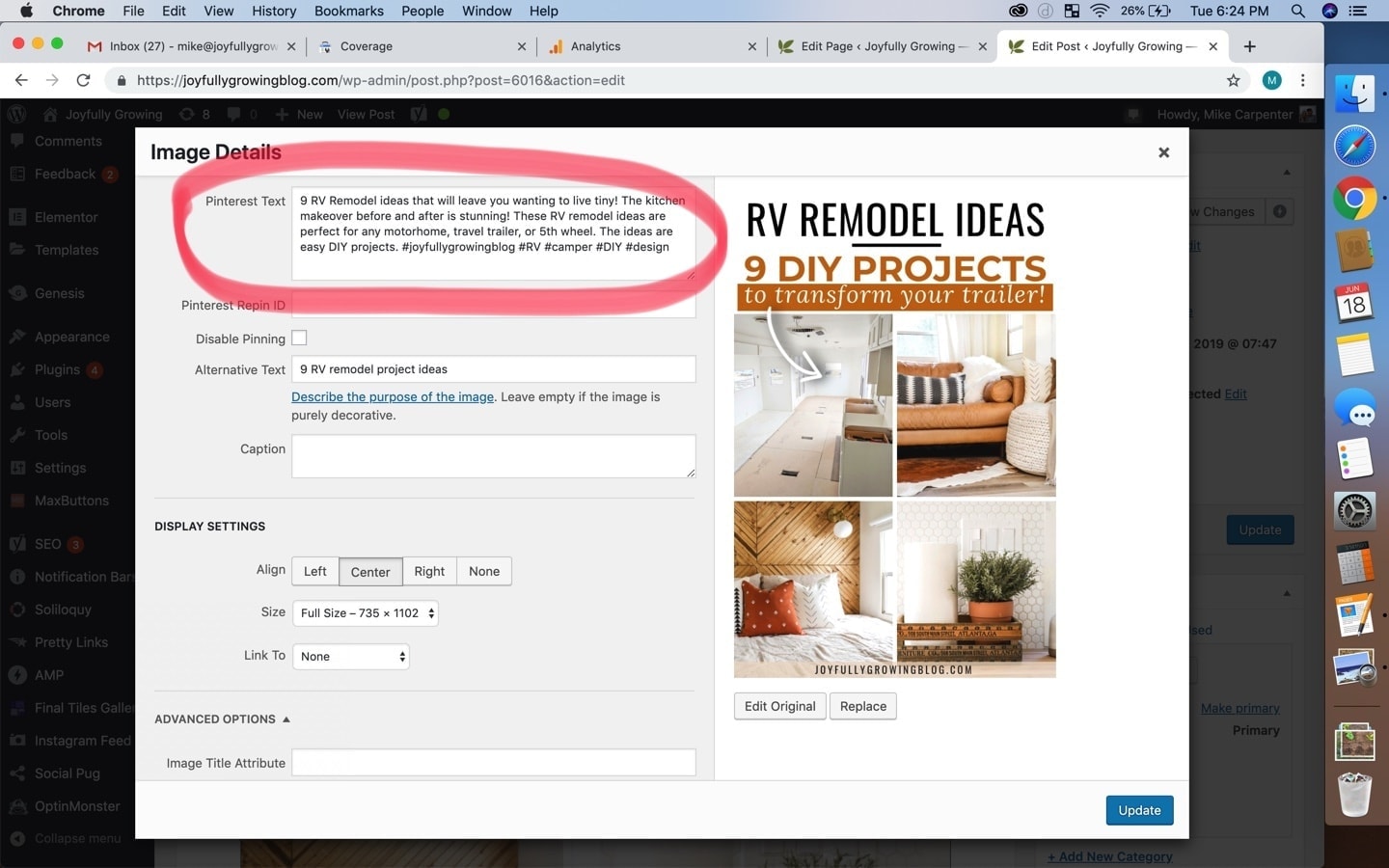
SEO Tip 4: Improve Your Alt Text and Image Names
Alt text, and image file names are both important aspects of on-page SEO for your website.
What is Alt Text?
Alternative text, or alt text, is an image description used by Google. The primary purpose of alt text is web accessibility. Alt text is read aloud to visually impaired users with a screen reader. This helps them to better understand the purpose of the image.
Secondly, if there is an error and an image file cannot be loaded, the alt text will be displayed as a backup.
Keep these primary purposes in mind when writing the alt text for images. Incorporate keywords whenever possible, but keep the text brief. Complete sentences, and punctuation is not necessary. 4 – 8 words is a good target to shoot for.
Use Keywords In the File Name Of Your Images
The file name of your images is another keyword opportunity. Use image file name as another place to put some keywords. You want to use every tool in your belt to make sure that Google understands your images, and is able to index them properly.
For example: If the image file below was named IMG_0321.jpg this would not give any clues about image is. Instead, name the file name to something like cold-brew-coffee-pouring-cream.jpg Make sure to change the file name BEFORE uploading onto your blog.
SEO Tip 5: Install the Yoast SEO Plugin
The Yoast SEO Plugin will help you optimize on-page SEO for your posts. Yoast analyzes your copy, and gives tips on ways to improve it. It will let you know if you’re using too much passive voice, or if your sentences are too long (or short). Yoast can help you improve your writing in many ways!
The free version of Yoast is an amazing tool, and works great to help bloggers improve their SEO. Yoast SEO Premium is available for $89/year, but especially when you’re just starting out with SEO, the free version will be plenty.
Keep in mind that you need to write content with your readers in mind. Your copy should be engaging, and easy to read. Ultimately, this is more important than making sure to get a ‘green light’ from the Yoast SEO plugin on every single blog post. Don’t obsess about over-optimizing.
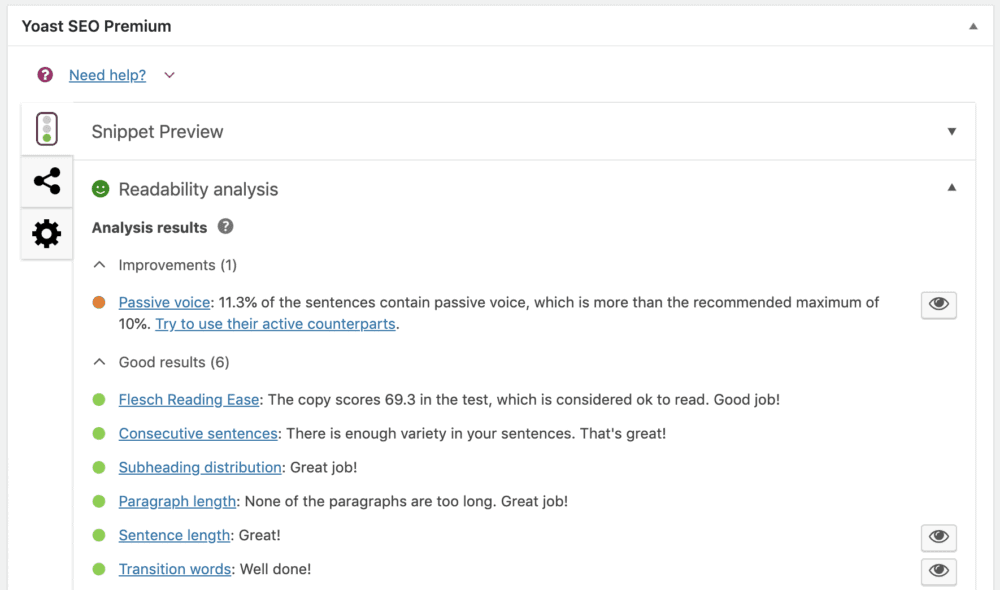
SEO Tip 6: Build Internal Links
An internal link is a hyperlink on your website, that links to a page on your site. Creating a good network of internal links between your pages is good SEO practice, and can help you gain credibility with search engines like Google.
Make sure to be strategic about where you place internal links, and to which pages you are linking. Link to other relevant content on your site.
Anchor text, is the ‘clickable words’ in a hyperlink. Try to use keywords in your anchor text. An easy way to write good anchor text is to use the title of the blog post you are linking to.
Tip: Change up your anchor text with slight variations so that all the links to a page aren’t identical.
Anchor Text Examples:
- Bad Anchor Text: To see an article on coming up with blog post ideas, click here.
- Good Anchor Text: For more information, read How To Come Up With Amazing Blog Post Ideas.
SEO Tip 7: Optimize H2 Headings & Formatting
You can have the best content in the world, but if it is not formatted in a way that makes sense to search engines like Google, it probably will not rank highly. Making an outline for a blog post BEFORE you write it can help keep you organized. It will also help with SEO!
When the Googlebot is crawling your website, it will read the title and the H2 headings first. In addition, the Googlebot will understand them to be the most important parts of the page. Make sure to put keywords in your title and H2 headings!
To make a H2 heading in WordPress, change the text type to ‘Heading 2’.
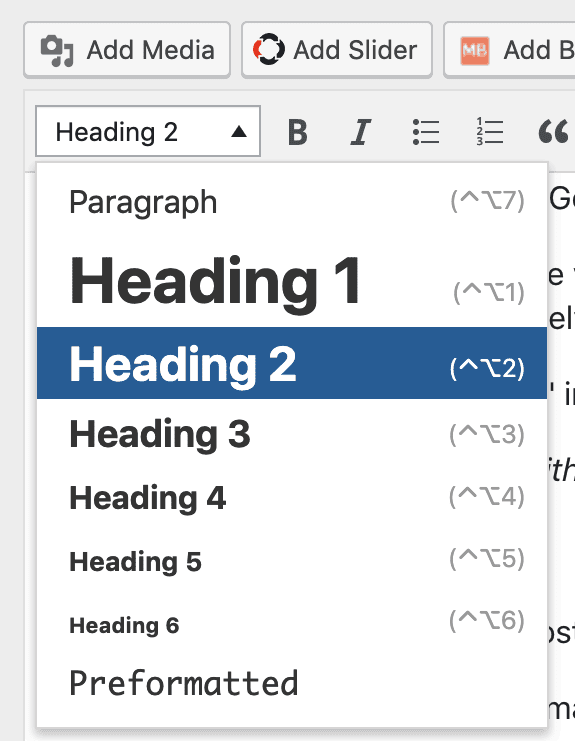
SEO Tip 8. Use A Good Permalink (URL)
A permalink is the URL name of a page on your website. For example, the permalink to this page is joyfullygrowingblog.com/seo-tips-beginners-blogging. Be strategic about the permalink that you choose. Keep permalinks short, and keyword-rich.

Permalinks are ‘permanent’ in the sense that they cannot be changed without creating a redirect, or error. Make sure to to set a permalink BEFORE publishing to avoid having to deal with redirects and errors.
Avoid using prepositions such as: ‘a‘, ‘the‘, ‘and‘, ‘of‘, ‘or‘, ‘for‘ in permalinks. The Yoast SEO plugin calls these prepositions: ‘stop words’.
Numbers are another thing that do not belong in the permalink. The reason is pretty simple. Consider this example. The title of this page is 11 SEO Tips For Beginners, but 11 should not be in the permalink. Why? So I can update and improve the page over time. If I was to come back after a few months and add two more tips, the list would grow from 11 to 13 tips. If 11 was in the permalink, it would no longer make sense. (And remember, you don’t want to change the ‘permanent’ permalink because you’ll have to deal with errors and redirects.)
Some WordPress themes automatically add dates to permalinks. If your permalinks have dates in them, this is hurting your SEO!
SEO Tip 9. Optimize Blog Post Titles
Having great blog post tiles is important. After taking the time to write amazing content, you want to make sure that people will actually click on your posts to see what you have to say!
Imagine you wrote a blog post about SEO and titled it “SEO Tools”. This title is boring, and not very descriptive! To get more search users to click through to the post, use a catchy, detailed title like: 11 Easy SEO Tips Every Blogger Needs To Know | Improve Your SEO!
SEO Tip 10. Improve Pagespeed
Pagespeed is important for both SEO, and user experience. If your pages take forever to load, people will not stick around!
Choose Your Web Host Wisely
The web hosting company you use has the #1 biggest impact on site speed and page-load times. All websites need to be fast if they want to rank highly on Google!
But Using a lightning-fast host isn’t the only thing you can do to improve pagespeed. The next way to improve page speed is to optimize your images.
Image Size Optimization
Optimizing the images on your site, can drastically improve page load time. Image files are huge, and can take a long time to load – especially if they aren’t sized and optimized properly.
An image with your camera’s native resolution such as 4000 x 6000 pixels is usually over 10 MB in size. To put this in perspective, I recommend keeping web pages under 3 MB (the entire page!). To achieve this, you’ll need to use drastically smaller images.
I recommend using images that are no larger than 1000 pixels, in the JPEG format, and compressed using the an image compression plugin.
Resizing an image from 4000 x 6000 to 1000 x 667 will reduce the size from 10+ MB down to about 0.5 MB. Next, use ShortPixel to compress the image and shrink down the size even further. I use the medium setting on ShortPixel called ‘Glossy’ which uses a good balance of compression and maintaining image quality.
Compressing using the ‘glossy setting’ reduces my image file size by 68% on average, which takes the 0.5 MB file, down to 0.16 MB.
In this example, the original 10MB image was 62.5X larger than the 0.16 MB optimized image! You can see why optimized images can speed things up a ton!
SEO Tip 11: Content Length
Most pages that make it to the first page of Google are long detailed articles. The top-ranking articles are always well-written, and include of tons of quality content. How long? Over 1500 words is a good minimum target, and 2000 – 3000 words is even better! There isn’t really a recommended maximum length to try to stay under. As long as you’re providing excellent, helpful content then feel free to keep chugging along.
Final Thoughts on SEO Tips for Beginners
SEO can be challenging, and frustrating at times if your organic search traffic isn’t growing rapidly. But stick with it! If you implement the 11 SEO tips from this list, you’re sure to start getting more traffic from Google.
Just remember that organic search traffic is the most steady and consistent type of traffic you can acquire for a website, which makes it worth all the effort.
Follow along on Instagram!







